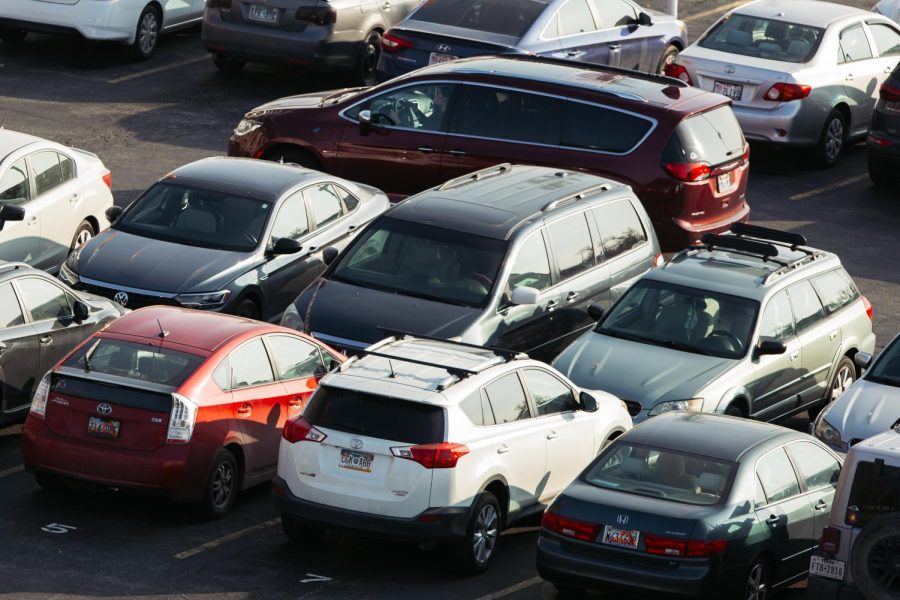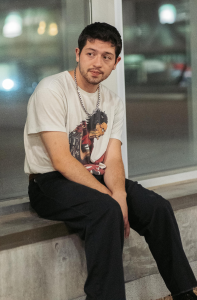Optimizing Campus Parking Amid Increasing Student Demand and New Construction
Student looking for parking at Rice Eccles Stadium in Salt Lake City, on Friday, Jan. 14, 2022 (Photo by David Chenoweth | The Daily Utah Chronicle
January 26, 2022
The University of Utah is gearing up for a series of construction projects. According to a post made by representatives of Commuter Services on Aug. 18, there are a total of nine construction sites on campus that are scheduled to break ground.
This construction is scheduled not just to build new facilities, but to remove several parking lots to make room for these new facilities. With a new threat to an already difficult parking situation, is it possible to understand why students have such a hard time finding a spot? More importantly, could the parking lots that already exist be further optimized to meet student demand?
Xianfeng Terry Yang believes the answer to both questions is “yes.” Yang is an assistant professor in the Department of Civil and Environmental Engineering who specializes in traffic operations, network traffic flow modeling and transportation infrastructure management.
“The main problem [for students finding parking] is that there are probably not enough ‘U’ spaces in lots close to buildings,” Yang said. “For example, I arrive at the campus at around 8 a.m. Over the course of the morning, there aren’t enough ‘U’ parking spots available while there are still many ‘A’ parking spots left. Because I use an ‘A’ permit I’m totally fine, but I can see how it might be very frustrating for students to drive along the different lots and not find a spot.”
Yang poses several ideas on how the university could optimize parking without building more parking lots.
“I think the university could maybe use some app to provide students with information on how many parking spots are available in each lot,” Yang said. “This could be really helpful and could save a lot of time for students. Right now, my research focuses on computer vision, and I’m thinking that maybe the university could use that as well. Imagine if we could have a camera installed in some lots that could capture the field of a parking lot. Then, we could process that information and calculate how many spots are free in the parking lot.”
Many existing parking lots on campus have a set time when students with ‘U’ permits are allowed to park, but Yang thinks this too could be further optimized using the models he specializes in.
“It would be very interesting to collect data on the spatial and temporal distribution of parking need,” Yang said. “For example, we may have like 10,000 students that have a ‘U’ parking permit, but how many of them want to use faculty ‘A’ parking spaces during different times of the day? If we could collect data on that kind of dynamic demand, we could run an optimization model that could calculate how best to allocate the parking for the two groups.”
One of the impacts of COVID-19 has been increased usage of parking on campus as a whole. According to Transportation Demand Manager for Commuter Services Solomon Brumbaugh, they have seen a major uptick in driving and a decrease in public transit usage.
“Historically, transit on campus has been very reactive, but we are now shifting towards being proactive,” Brumbaugh said. “The reactions to COVID have been really fascinating. The change that we’ve seen in commuter behavior is an increase in the use of single-occupancy vehicles. Also, people are riding transit less because you’re in a crowded place, so there’s still a lot of hesitancy.”
Using intelligent cameras to count free spaces like Yang suggests is just one of many considerations when looking to optimize the parking situation on campus. Brumbaugh explains that there are major hurdles to this concept.
“There are privacy issues, reliability issues and networking issues to name a few,” he said. “You can’t just store pictures of people. How are these devices getting powered? We’ve had issues with solar power before. You need to have a reliable system where it can stay dark for a week and still work. We also don’t want yet another app for the campus, so this technology would need to be seamlessly integrated into something like the campus map. New projects on campus are already beginning to jump these hurdles, but precision remains the biggest one.”
Brumbaugh also explained how Commuter Services is currently taking steps to improve parking.
“People aren’t robots, and that’s the biggest problem,” he said. “Parking lot counts and usage are how we currently decide on how many types of a certain stall are in a parking lot. When we go into a parking lot that has 50% ‘A’ stalls and 50% ‘U’ stalls, but the ‘A’ stalls are always empty, we shift a whole bunch to ‘U’ stalls to meet the demands of community parking lots. My biggest project right now is the Commuter Survey that just went out last year, where students and staff self-report and provide feedback. It’s a great way to come up with novel ideas.”
According to Associate Director of Commuter Services Nicole Tatom, as of February 2021, the Commuter Services Information Center reports a total of 29,304 parking spots, including Pay by Phone, Visitor stalls, Maintenance stalls, Load Zone Meter stalls, EV charging stalls, ADA/Disabled stalls, Reserved stalls, Garage stalls, Housing stalls, ‘A’ stalls, ‘U ‘stalls and more.










